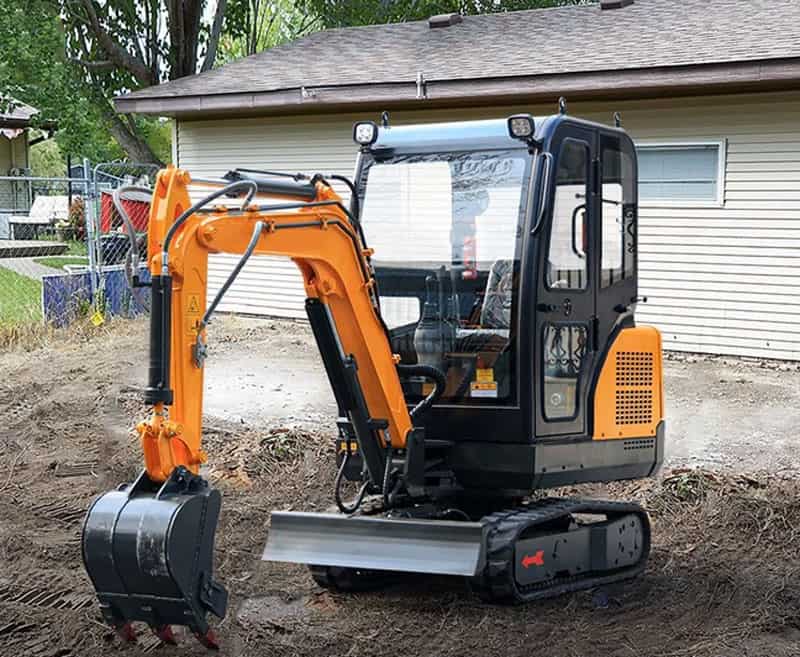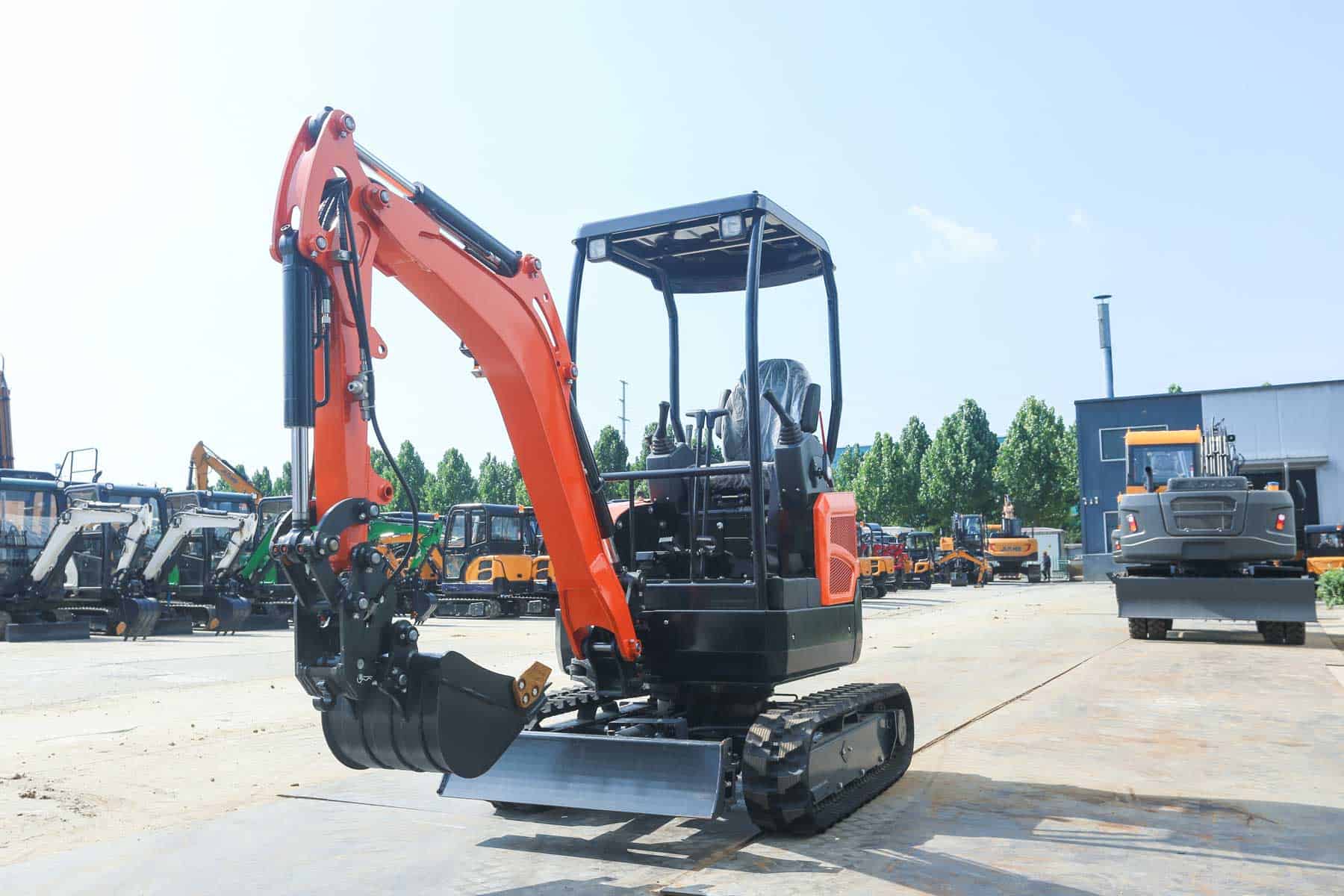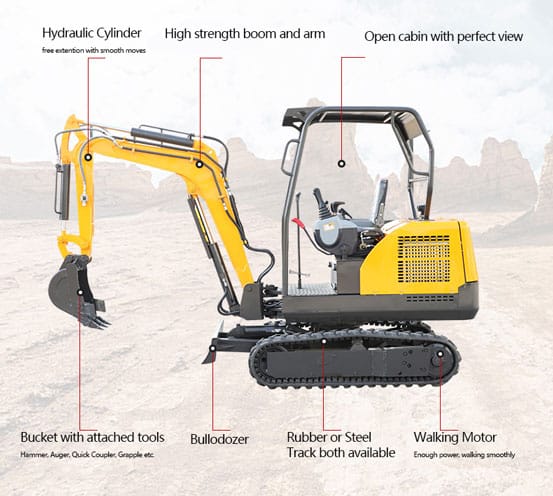Introduction to Micro Excavator:
A micro excavator is a wheeled or tracked vehicle which is used most often in the construction industry. It can weigh between 10,000-20,000 pounds.
How to Use A Micro Excavator?
The micro excavator has a key role in the construction industry. It makes the process of construction more efficient and safe. The small size of the micro excavator allows it to move into narrow areas and speed up different tasks. Here are the key points or steps to using a micro excavator correctly.
Trained operator:
Any machine or vehicle in the hands of an untrained person is dangerous; the same is the case for micro excavators. The operator should be properly trained and experienced along with an in-depth knowledge of micro excavators before he/she starts operating them on site.
Reading, understanding, and following of operational manual:
Before starting operating a micro excavator it’s really important to go through the operational manual properly even for a trained operator. Pay attention to the steps of using every control and its description. Check the warning signs on the machine. Warnings help you to determine when not to use the machine and what danger signs you should watch out for. Check the coolant levels and engine lubricant before using it and make sure you know where the fire extinguisher is.
Testing the machine:
Micro excavators mostly use either a standard ignition with a key or a digital keypad. Fasten your seat belt properly. Although micro excavators don’t have a high-speed seat belt that protects you if the machine overturns. The ideal location for testing is a large open area with a leveled surface. Although micro excavators are pretty stable a leveled surface reduces the risk of overturning the machine for inexperienced operators. Get a feel for the machine and go through all the controls. Get used to the rotating cabin. It will enable you to see how smoothly controls respond to your inputs.
Get familiar with driving on tracks:
Micro excavators mostly use rubber tracks that move only forward and backward. For any new operator, it’s imperative to get used to this limited range of wheel motion. Controls let you move the right and left tracks on their own. The separate movement of each track allows you to turn in all directions. Using the hand controls together you can move the machine backward or forward. All these things require time and proper training and practice.
Ensuring the correct balance:
Balance is really important for any machine, particularly smaller machines. In case you don’t balance the weight of the micro excavator correctly, you’ll end up tipping. The micro excavator can be balanced by extending or retracting the stick.
We can also take a look at this video for more information.
Steps of Using Micro Excavators:
Lower down the blade:
Lower the down the blade by using the control lever until it tilts up the machine slightly.
Applying the power:
The use of micro excavators’ power is a tricky thing. If you’re relatively new to operating the machine then prefer to use half power initially unless or until you get more comfortable in operating the machine.
Positioning of stick and bucket:
Push the primary stick to extend the stick outward to start excavating. When the stick is extended about halfway then use the bucket control to angle the bucket. Lower down the boom until the teeth of the bucket touch the ground. Adjust the angle precisely according to the requirements through joysticks.
Digging:
Pull the stick to make the bucket rightly positioned for digging the earth. You can swivel the boom and dump the dirt if you have a swing boom or variable angle boom. Or turn the mini excavator and drive the dirt to the established dumping location.
Precautions while using micro excavator:
Wear proper personal protective equipment:
Personal protective equipment ensures the safety of the operator. Wear a reflective vest to make yourself more visible and durable work boots to protect your feet. Wear a helmet and clear or tinted safety glasses. Wear gloves and ear protection as well.
Three points of contact:
Both while entering and exiting the mini excavator make sure you maintain three points of contact with the machine every time. These three points of contact can either be both feet and a hand or both hands and a foot. Maintaining these contact points helps you to improve your stability and minimizes the chances of falls and slips.
Seat belt:
Now day’s seat belts are there in micro excavators. These retractable seat belts protect you from injury if the machine is overturned or collides with something.
Use of safety interlock:
Safety interlock is an important feature in micro excavators. This safety interlock prevents you from bumping into levers and accidentally moving the machine in a way that would injure you as you exit the machine. Raising the safety interlock provides you more space to get out locks the components of the excavator in place and ensures the safe exit of the operator.
Use of camera feature:
The camera feature is a great assistance for the operator to view the perimeter around the excavator to avoid people or colliding with nearby objects.
Common Issues in Micro Excavators:
Tension in tracks:
Tracks of the excavators become loose at times. If the track is loose then it becomes difficult to maneuver it around a construction site which results in wear and tear. To achieve maximum efficiency on consistent basis tracks of the excavator should be properly tightened.
Contamination:
Contamination in the oil is also a common issue in excavators. Contamination can happen even with the smallest particle getting into the oil.
Oil contamination mostly happens in the final drive motor of a micro excavator. So operator should make sure that there is no foreign particle in the oil which could cause serious damage.
Leakage:
Leakage is almost unavoidable and it can happen anytime. In heavy machinery, there are oil leaks occasionally. Oil leakage can lead to low oil levels which can cause failure in the excavator if went unnoticed. Instead of just refilling the oil find the source of leakage and fix it.
Hydraulic pump failure:
Hydraulic pump failure happened when you don’t check the hydraulic oil. It can lead to expensive damage to the engine.
Gearbox faults:
Just like any other vehicle gearbox is primarily the transmission of the excavator. If the excavator is old then the gearbox can be malfunctioned and may require a change. The best possible way to avoid all these issues is to keep inspecting and maintaining the excavator time and time again. Check oil level and keeps the parts nice clean.
Recommended Services Intervals:
- 10 hours check and fill the fluids in vital parts like hydraulic, engine, and radiator
- 50 hours examine the tension of tracks and adjust if needed
- 250 hours Analyze the condition of the battery and clean it
- 500 hours Change the engine oil and filters
- 1000 hours Change the swing reduction gear case
- 2000 hours change the coolant of radiator
- 5000 hours change the hydraulic oil even if it doesn’t appear cloudy or dirty
Excavation Hazards:
- Damage to underground transmission facilities
- Materials, equipment, and personal vehicles falling inside the excavation
- Soil collapse due to loose soil and heavy equipment movement
- Occurrence of flammable and toxic gases
- Exposing the foundation of the already existing building
Excavation Safety Precautions:
- Detect the underground facilities before starting excavation by using a metal or cable detector
- Adapt soil protection methods such as stepping, sloping, shoring, and close sheeting
- Put up proper barricade and excavation sign boards at the site
- Test the presence of any gases before starting
- Provide temporary support to the existing foundations to avoid falling down
- There should be at least two means of access for a person working inside the excavation if the walking distance is more than 7.5 meters
- Excavated soil, equipment, and materials should be maintained at a distance of 0.5 meters away from the edge of the excavation
- A signalman should always be present with heavy equipment like excavators, dump trucks, and loader
Excavator Requirements:
- A valid construction license for the operator
- A hot work permit other than the Excavation Authorization is needed
- Valid safety certificates
- Awareness of the operator about the blind spots where they do not see the people on the ground
- Certified signalman or flag man with flags
- No one should be in the excavation while the excavator is working
- The bucket should always be on the ground when not in use
- No hydraulic leakage
- Spark arrestor
Uses of Micro Excavator:
Digging:
Micro excavators can also be used to dig holes because of their ability to move around in hard-to-reach areas and the variety of attachment options they have. Old-fashioned shoveling is an exhausting process that can extend the completion time of the project compared to that digging with a mini excavator is an efficient and effective option.
Landscaping:
A micro excavator can also be used for planting trees and shrubs and for making irrigation ditches. These can also move around without leaving heavy marks or damaging the soil or plants.
Demolishing the buildings and structures:
Micro excavators are also handy for demolition. Although these are not preferred to demolish a full-sized building in many construction projects small tearing down is required. Micro excavators are useful for that. These are much more efficient and safer than hand-powered tools to tear down small structures. Micro excavators are handy when you need to reach high structures. If you don’t use a micro excavator with a longer boom then there is a risk of getting close to the project while reaching up high. You can also use that micro excavator to dump all the waste from the shed or barn into the trailer or crawler dump to clean your farm.
Installing the outdoor structures:
Installation of outdoor structures like hot tubs, pools, etc requires an effective and convenient way to excavate all the dirt. This is where micro excavators come into play. Micro excavators get the job done easily.
Repairing the sewer lines:
Micro excavators are better options as compared to a full-sized machine like a trencher for basic sewer line repair. This is because micro excavators can do the same job at a lower cost as compared to larger machines. While using a micro excavator for these kinds of jobs assesses the required digging depth and makes sure it’s within the reach of it. If the depth is within the range then it doesn’t make sense not to use this tool for these types of jobs.
Plowing the snow:
Clearing the roads covered with snow needs some kind of efficient machinery. Micro excavators can clear snow effortlessly using a specialized blade attachment. Their low weight and compact size make them suitable for clearing snow-covered roads.
Drilling:
Drilling is something that is closely associated with the micro excavator. Micro excavators are designed with a wide range of attachments specialized for drilling. Such as an auger that is equipped with teeth for drilling. So these can drill deep easily into concrete or soil. Tree augers have a small diameter on the bottom which is mounted to a larger diameter on top. So it can produce holes for planting trees. Rock bits are the toughest type of auger which is custom made for digging in solid rocks and concrete.
Final word:
Micro excavators can easily turn down a time-consuming project into a DIY project. This amazingly powerful machine can perform a wide range of tasks, from making planting a tree, digging a trench, or installing the first pool or spa. A micro excavator can easily maneuver around the obstacles in the yard or on the construction site and with its retractable undercarriage; you can get through narrow spaces without any problem. Micro excavators work with more efficiency when rubber tracks are tight and in good condition. These rubber tracks increase the flotation of the machine and provide the traction needed to climb dirt slopes. Replace your rubber tracks when you notice exterior cracks, loose or missing lugs, or lack of tension in those.
If you have an interest in mini excavators, kindly please contact us now. We are one of the leading micro excavator manufacturers based in China. Any of your questions are welcome.







